Key takeaways:
- Transitioning from PHP to Laravel streamlined development processes with features like Eloquent ORM and Artisan, enhancing efficiency and creativity.
- Laravel’s robust community offers extensive support, fostering collaboration and shared insights among developers.
- Initial challenges included mastering Laravel’s conventions and the learning curve of its extensive ecosystem, particularly with Eloquent for database interactions.
- Utilizing resources like online courses, books, and GitHub repositories greatly facilitated the learning process during the transition to Laravel.
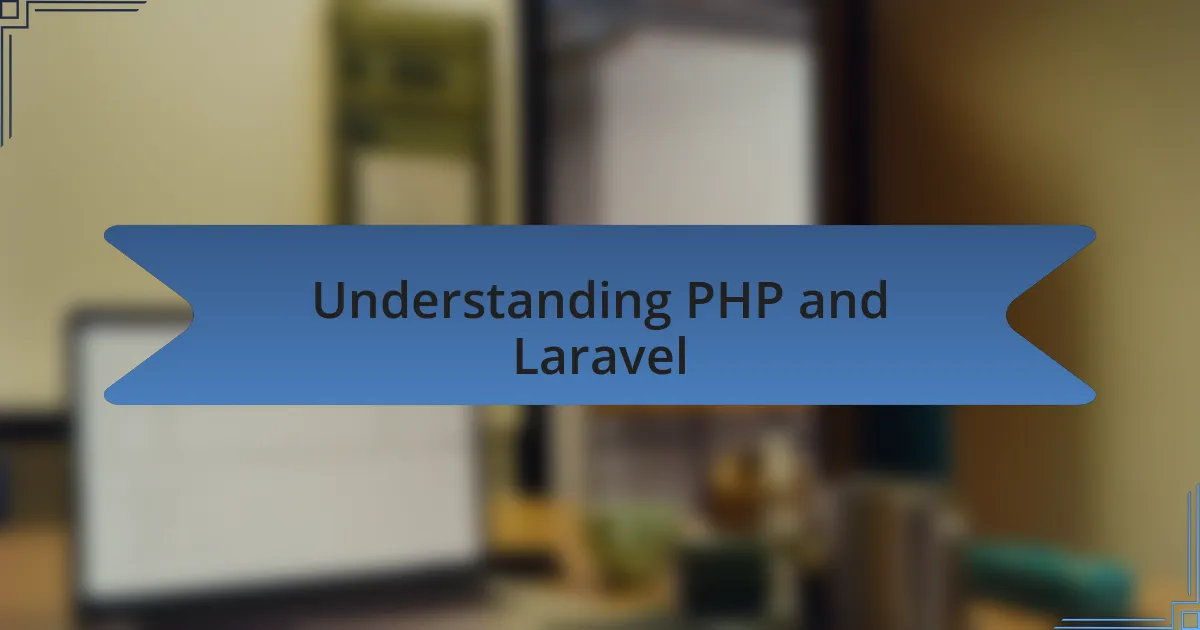
Understanding PHP and Laravel
PHP has been a cornerstone of web development for many years, and I can’t help but remember the sense of accomplishment I felt when I first wrote my PHP code and watched it run seamlessly on a web server. This server-side scripting language is powerful and versatile, making it a popular choice for creating dynamic web content. Yet, as I navigated the complexities of larger projects, I began to wonder, “Isn’t there a way to streamline this process?”.
That’s when I discovered Laravel. I was initially impressed by its elegant syntax and the ease with which it managed tasks like routing and database migration. The ability to use Eloquent ORM (Object-Relational Mapping) was a game changer for me. Suddenly, I could interact with my database using expressive syntax instead of writing complex SQL queries. This shift not only improved my efficiency but also sparked a new passion within me for elegant coding practices.
Transitioning from PHP to Laravel felt like upgrading from a basic toolkit to a high-end workshop. I remember the first time I built a simple application using Laravel’s built-in features—things just clicked into place. Have you ever experienced that moment when everything falls into place, and you realize you’re finally working smarter, not harder? That was my experience with Laravel, and it filled me with a newfound enthusiasm for development.
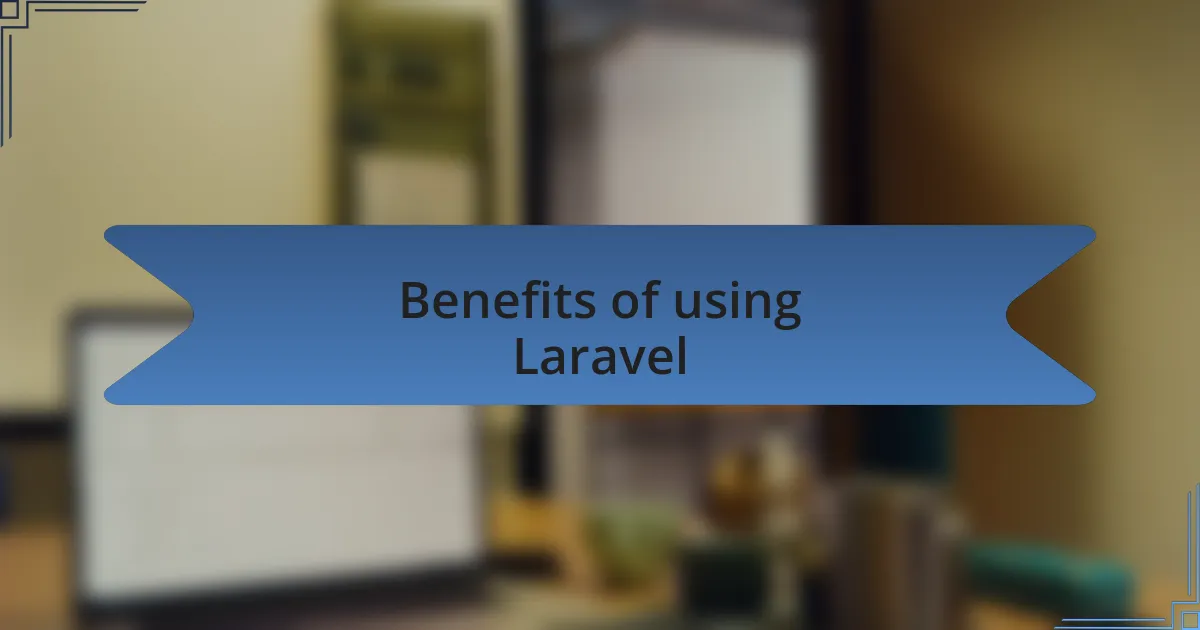
Benefits of using Laravel
One of the standout benefits of using Laravel is its powerful ecosystem and robust community support. I vividly remember the sense of camaraderie I felt while navigating through Laravel’s documentation and forums. Whenever I encountered a challenge, there was always someone willing to share their insights or solutions. This collaborative spirit not only helped me overcome obstacles but also deepened my connection to the framework and its vibrant user community.
Another major advantage is the built-in tools that streamline development tasks. When I first utilized Laravel’s Artisan command-line interface, it was like having a personal assistant. I could effortlessly generate boilerplate code and perform migrations in just a few keystrokes. This drastically cut down the time I spent on repetitive tasks, allowing me to focus more on crafting the unique aspects of my projects.
Security is another point where Laravel shines, something I didn’t fully grasp until I faced a security issue in one of my earlier PHP projects. With Laravel’s built-in security features, such as protection against SQL injection and cross-site request forgery, I felt my applications were much safer. This helped me build confidence as a developer. Have you ever worried about potential vulnerabilities in your code? With Laravel, I was relieved to know that many of these concerns were already addressed, so I could concentrate on delivering high-quality applications.
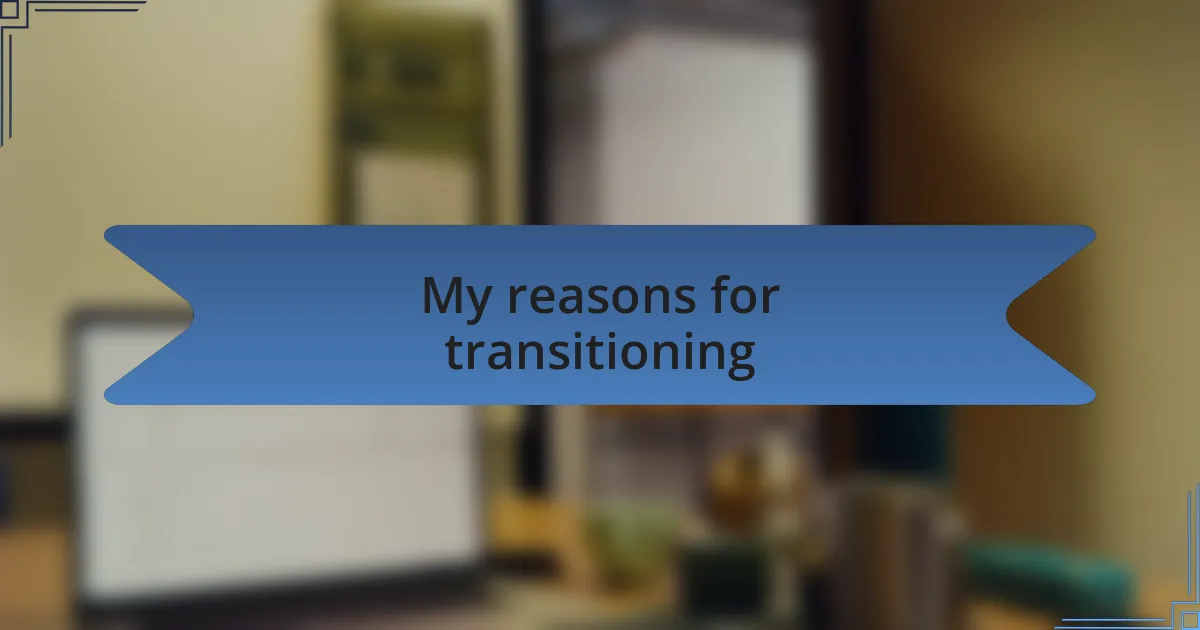
My reasons for transitioning
When I first considered moving from PHP to Laravel, it was the framework’s elegant syntax that truly caught my attention. I remember diving into my initial projects and feeling that writing code became less about struggle and more about creativity. Have you ever had that experience where everything clicks, and you can express your ideas seamlessly? That’s exactly how I felt transitioning to Laravel.
Another significant reason for my shift was the desire for a more streamlined development process. I recall spending countless late nights wrestling with bugs and manual tasks while working in pure PHP. The moment I discovered Laravel’s robust features—like Eloquent ORM for database interaction—it was like someone handed me a toolbox filled with precise instruments. This newfound efficiency transformed my workflow, allowing me to build better applications in less time.
Moreover, the sense of belonging to a thriving community was an emotional game-changer for me. While coding in PHP, I often felt isolated, but once I started engaging with others in the Laravel community, it was a revelation. I found forums and Discord channels bustling with developers sharing their stories and solutions. How could I resist being part of such an inspiring environment where collaboration is the norm? That sense of unity motivated me to embrace the transition wholeheartedly.
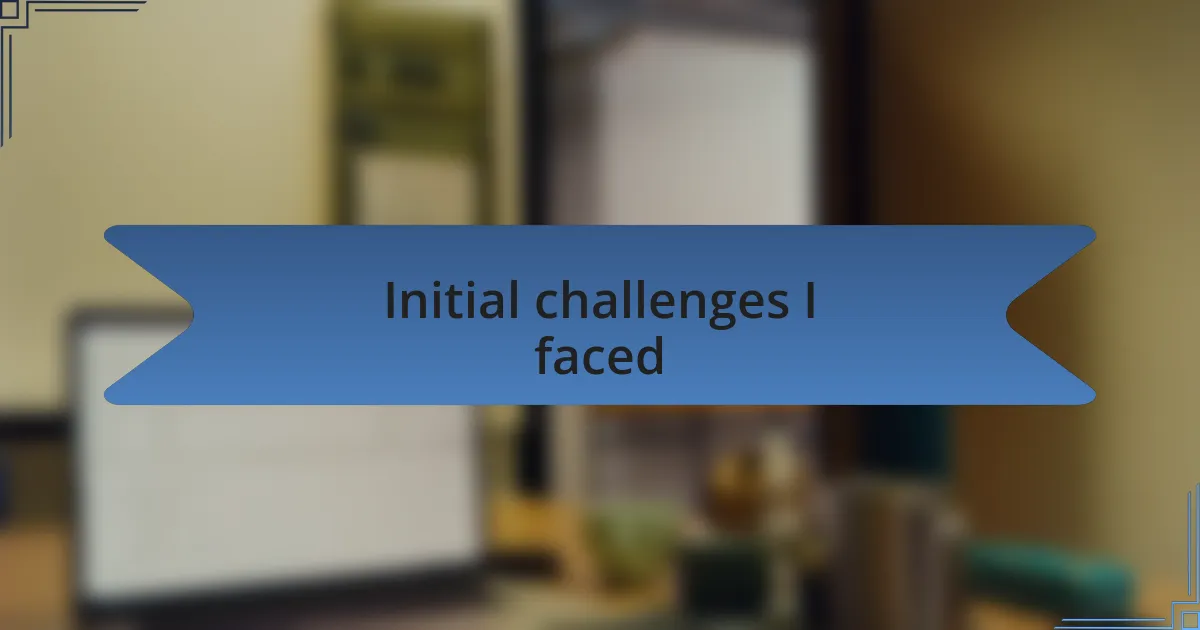
Initial challenges I faced
One of the initial challenges I faced during my transition to Laravel was mastering its conventions and features. Coming from a pure PHP background, I was used to a more free-form approach. Suddenly, I was confronted with a framework that had its own set of rules and best practices. I remember spending hours sifting through documentation, feeling a mix of excitement and frustration. How could I adapt my coding style to align with Laravel’s structured methodology?
Another hurdle was overcoming the learning curve associated with Laravel’s extensive ecosystem. For instance, when I first encountered Artisan, Laravel’s command-line tool, I was both intrigued and overwhelmed. It seemed like a powerful ally, but I kept asking myself—was I ready to take advantage of its capabilities? Coupled with my previous experience, this new world of features and functionality challenged me to expand my skill set rapidly.
Then there was the adjustment to using Eloquent for database interactions. In PHP, I had developed a basic understanding of SQL queries, but working with Eloquent’s object-relational mapping was a complete shift. I recall the moment when I successfully implemented a simple database relationship; it felt like I had turned a corner. But I often wondered—would I ever fully grasp the complexities of these relationships without losing my grasp on the fundamentals? This push and pull between the familiar and the new was both daunting and invigorating.

Tips for learning Laravel
When diving into Laravel, I found that setting up a local development environment made all the difference. Initially, I tried to configure everything manually, which led to unnecessary headaches. Instead, I discovered the power of Laravel Homestead—a pre-packaged Vagrant box. It streamlined the process, allowing me to focus on coding rather than setup woes. How much time could I have saved if I had known about this earlier?
Another tip I wish I had embraced sooner is to engage with the community. I joined forums and Laravel-specific groups, where I encountered both beginners and seasoned developers. Sharing experiences and asking questions revealed invaluable insights that I wouldn’t have found in the documentation alone. The camaraderie and support felt like a safety net as I navigated through challenges. Have you considered connecting with others to enhance your learning journey?
Creating small projects was a game-changer for me. Instead of trying to tackle a large application from the get-go, I broke down my learning into bite-sized pieces. For instance, building a simple blog or a task manager using Laravel helped reinforce my understanding of routing, middleware, and controllers. Each small win boosted my confidence significantly. Have you thought about what kind of mini-projects could solidify your grasp on Laravel’s features?
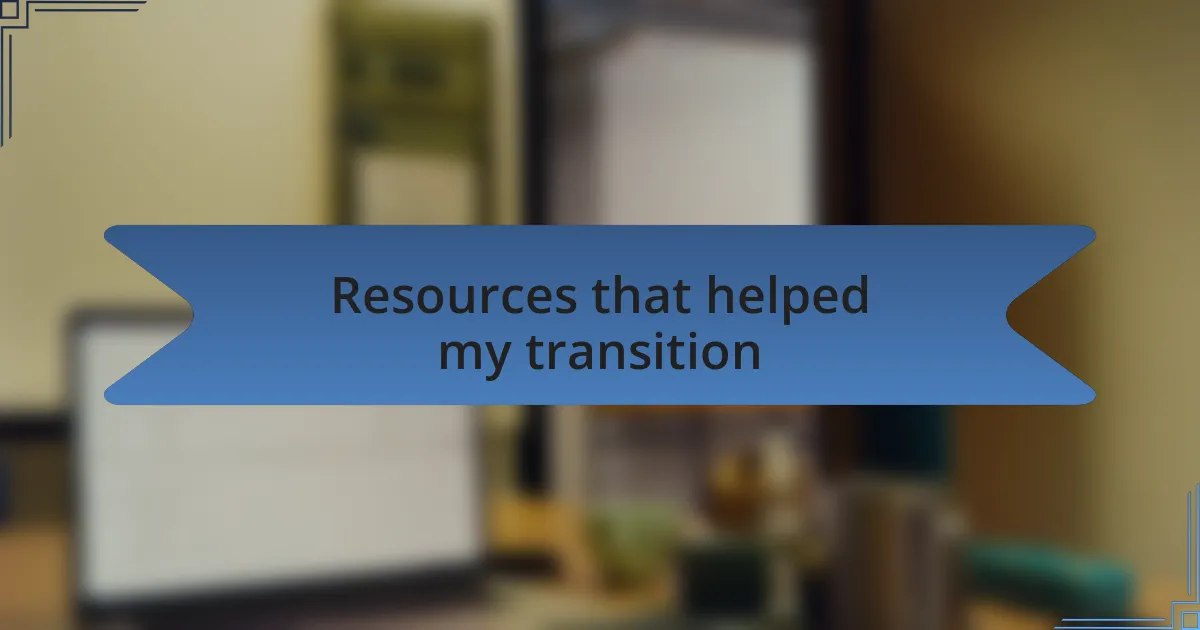
Resources that helped my transition
I can’t emphasize enough how much online courses helped me during my transition. I stumbled upon a few great platforms like Laracasts, where the bite-sized videos really resonated with me. The clarity of Jeffery Way’s teaching style transformed the way I understood Laravel’s features. Did you ever find a course that just clicked for you?
Books also played a crucial role in my learning curve. I picked up “Laravel: Up and Running,” and it felt like having a mentor by my side. The practical examples provided a robust foundation, and I remember staying up late, flipping through the pages to grasp concepts like Eloquent and Blade templating. Isn’t it fascinating how a well-written book can change your perspective?
Lastly, GitHub repositories were invaluable for hands-on learning. I actively explored projects that used Laravel, taking inspiration from the code and implementation techniques. It was like looking over someone’s shoulder while they crafted their masterpiece, and I often found myself excitedly adapting snippets of code in my projects. Have you explored the wealth of knowledge available in open-source projects?